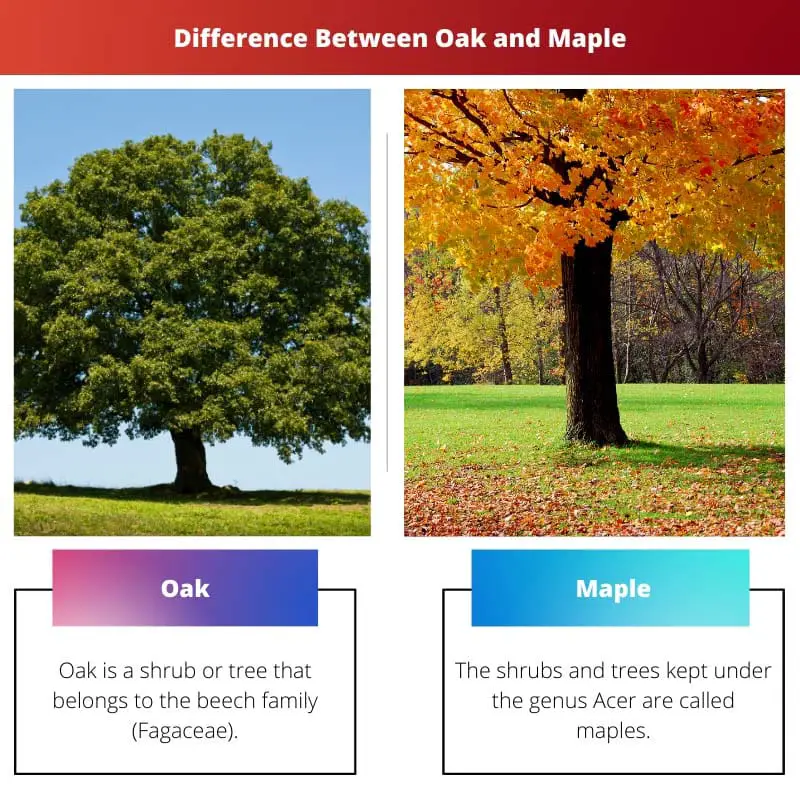Oaks and maples both belong to the deciduous angiosperm family. Thus both are classified as hardwood. Oak and maple wood has certain similarities like durability and weight, but they still differ a lot in coloring and graining patterns.
So, the differences between oaks and maples are pretty notable, and one can’t mistake identifying them one from the other.
Key Takeaways
- Oak is denser and more durable than maple.
- Oak has a more prominent grain pattern than maple.
- Maple is lighter in color and has a smoother texture compared to oak.
Oak vs Maple
Oak is a type of tree. The wood texture of oak is grainy. The color of the wood of the oak tree is white. The total number of oak species that can be found is around 500 from all over the world. Maple is another type of tree. The wood texture of maple is smooth. The color of the wood of the maple tree is white-yellow.

Oaks are attractive trees, hard in nature, and are, thus, used for the same. Their botanical name means “Beautiful tree.” They are used for making timber furniture, providing shade, and for medicinal purposes.
The formation of galls is found on a few oaks during autumn and summer and holds eggs of insects in it.
Maple has distinctive leaves and fall color. There are a number of maples of different heights- from very small to a height of 60ft or more. They are susceptible to a number of pests and insects. Symptoms of tree decline happen in urban locations because of pollution, soil salts, etc.
Comparison Table
| Parameters of Comparison | Oak | Maple |
|---|---|---|
| Genus Name | Quercus | Acer |
| Leaf Shape | Ovate to oblong with a narrow base | Irregularly ovate, sinuate, and pointed |
| Fruit obtained | They possess acorns | They possess samaras |
| Wood texture | Grainy | Smooth |
| Wood color | Cream or white | White-yellow or reddish-brown |
What is Oak?
Oak is a shrub or tree that belongs to the beech family (Fagaceae). Other than the name oaks, they can also be known by the names like silky oaks, stone oaks, and she-oaks, depending on the species the genus of Quercus possesses.
Oaks are basically indigenous to the Northern Hemisphere. They might also be spotted in the topical and cool temperate latitudes of North Africa, Asia, and America. There could be around 500 extant oak species available all around the world.
They could be classified into three groups- white, red, and black oaks. White oaks possess non-bristle, tipped, and smooth leaves. They occasionally also have glandular margins. The acorn evolves in a single season, germinates in a few days after the falls, and owns sweet-tasting seeds.
Black or red oaks are pretty bristled and own acorn hair-lined shells. The fruits are quite bitter in taste and develop wholly by the second growing season’s end.
Oaks could be propagated effortlessly from acorns and grow great in moderately rich, moist, or sandy, dry soil. Most oaks develop again from sprouts’ stump. They are long-lived and hardy but can’t tolerate shade and might get spoilt by oak wilt fungus and leaf-eating organisms.

What is Maple?
The shrubs and trees kept under the genus Acer are called maples. There are around 132 species of maple all around the world. They are basically native to Asia, but one can spot them in North America, Europe, and northern Africa.
Maples are considered amongst the most prominent group of ornamental trees that you can plant in parks, lawns, and along the streets. Several species can also be utilized to get maple syrup and grab hardwood to make furniture.
The smaller maple involves the species named- field or hedge maple, ginnala maple, etc. They are very useful in hedges or screens and possess outstanding foliage during falls. The vine maples are shrubby, wide-spreading maples that have beautiful purple and white flowers.
The medium-sized maples are around 30 feet tall. Such maples include the Miyabe maple, big-toothed maple, and Coliseum maple. They appear to be yellowish-golden in look and have attractive peeling bark and tripartite leaves.
Large maples exceed the size of 30 meters and are planted actually for shade purposes. These include red, silver, and sugar maples. They own an orange-bright foliage fall and provide wood that is pretty darker than the other maple woods.

Main Differences Between Oak and Maple
- Oak is very much resistant to insect and fungal attacks because of its high content of tannin. On the other hand, maple gets affected by fungal diseases very easily.
- Most oak trees flower in the spring season, while the maple has a flowering season in early spring or late winter.
- The oak wood possesses pores on its bark that are easily spotted by the naked eye. Whereas maple wood doesn’t have such visible pores and thus has a smooth texture.
- All oak species’ grains show a well-defined and distinctive pattern, while maple grains have a light pattern that isn’t easily visible to the eyes.
- Oaks, on a general basis, are used as shade trees or focal specimens, etc. On the other hand, maples are used as ornamental and patio trees, syrup making, etc.

- https://onlinelibrary.wiley.com/doi/abs/10.1111/ppl.12331
- http://dspace.lzuu.lt/bitstream/1/2901/3/rural_development_2009_vol_2.pdf#page=196

The article effectively delves into the botanical and ecological aspects of oak and maple trees. It offers compelling insights into their characteristics and uses.
I couldn’t agree more, Stewart Alice. The depth of information provided in the article is truly commendable, offering a valuable learning experience.
Indeed, Stewart Alice. The article provides a thorough analysis of oak and maple trees, making it an engaging read for those interested in botanical studies.
I was unaware of the distinctions between oak and maple, but now I feel well-informed. Thank you for providing such detailed and accurate information!
I agree with you, Daniel. It’s refreshing to find an article with such precise botanical knowledge. It’s a valuable resource for nature enthusiasts.
The article has a nice blend of scientific facts and practical uses of oak and maple trees. It’s a well-balanced and engaging piece of content.
I agree, Green Tim. The article effectively captures the essence of these trees while providing valuable insights into their applications.
While the article conveys detailed information, it lacks a touch of humor or wit to make it more engaging and entertaining.
I understand your perspective, Dennis Simpson. A bit of humor could indeed enhance the reading experience and make the content more relatable.
I respectfully disagree. I find the straightforward and informative tone of the article to be very effective in delivering scientific information.
While the article is informative, I think it lacks more in-depth analysis of the environmental and ecological impact of oak and maple trees.
I understand your point, Handerson. It would be interesting to examine how these trees contribute to their ecosystems and the implications of their decline.
I agree with you. It might be beneficial to explore the broader implications of oak and maple trees beyond their physical characteristics.
The article’s focus on the distinctions between oak and maple trees enriches the readers’ understanding of these species. It’s a well-crafted piece of botanical literature.
I wholeheartedly agree, Randerson. The article’s attention to detail and scientific accuracy makes it a valuable resource for learning about these trees.
This post presents such clear and comprehensive facts about oak and maple trees. A great read for anyone interested in botany and nature!
Absolutely, this article not only educates but also inspires interest in these wonderful trees. I’m enjoying the insights shared.
Very informative article! I appreciate the detailed information on the differences between oak and maple trees. It’s fascinating to learn about their unique characteristics and uses.
I absolutely agree. It’s very enriching to learn about the botanical aspects of oak and maple trees. I found the comparison table particularly helpful.
This article has definitely broadened my knowledge about these trees. I’m impressed by the depth of explanation and scientific detail provided.
The comparisons drawn between oak and maple trees are intriguing and well-supported. The article is a commendable source of educational content.
Absolutely, Max Russell. The article presents a clear and concise analysis, making the learning experience both engaging and enriching.
I appreciate the thorough analysis of oak and maple trees in this article. It’s a great reference for anyone looking to expand their knowledge of botanical science.
I concur with you, Evans Luke. The depth of information presented makes this article a valuable educational asset for those interested in botany.
Absolutely, Evans Luke. The article serves as a comprehensive guide to understanding the characteristics and distinctions of oak and maple trees.